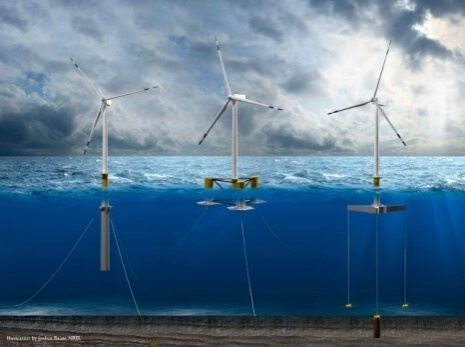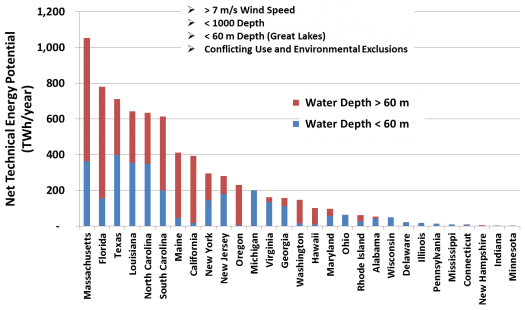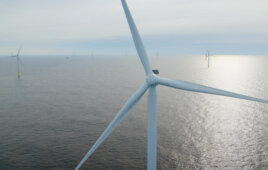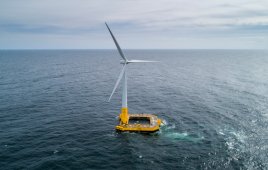This blog comes from the EERE, and is part of a series that explores offshore wind technical challenges that are different in the United States than in other countries.
Worldwide, 13,000 megawatts of offshore wind has been deployed —yet the U.S. only has one offshore wind farm.
For the last year, the Block Island Wind Farm has been operating off the coast of Rhode Island.
As the United States looks to deploy more offshore wind, several U.S. specific technical challenges will need to be overcome. This blog addresses challenges posed by deep waters (stay tuned for future blogs on other U.S. offshore wind topics such as hurricanes, vessels, and installation techniques).
The Consortium
Today, the U.S. Department of Energy (DOE) announced a funding opportunity to establish an offshore wind research and development (R&D) consortium. This consortium will bring together a diverse group of researchers who will add to the offshore knowledge base in an accelerated manner. It will include members of the offshore wind industry, who will contribute funds and expertise to the research results and validate technologies developed by the consortium.

Offshore wind floating substructure designs: spar buoy (left), semisubmersible (middle), and tension-leg platform (right).
Photo: Josh Bauer, NREL
The Challenge
One significant challenge to building offshore wind turbines in the United States is the depth of the waters along many coastal areas. While most European installations to date have occurred in shallow waters, most (roughly 60%) of our nation’s offshore wind resources are situated in deep waters — more than 60 meters down (or nearly 200 feet). This means traditional bottom-mounted foundations aren’t economically viable in these areas.
The Technology
So, how does the U.S. overcome this challenge? It may seem like something out of a science fiction story, but researchers and engineers are finding ways to create platforms that float while giving the top-heavy turbine enough stability to operate effectively. Tethered to the sea floor, floating foundations allow wind turbines to operate in areas where water depths may be greater than 165 feet. Floating foundation technologies make offshore wind feasible in locations, including California (where nearly 95% of the available offshore wind resource has a depth greater than 60 meters), Hawaii, and Maine.
 This technology, largely adapted from the oil and gas industry, is already successful at the prototype stage, with more extensive test and demonstration projects underway. Currently, the most cost-effective installation method appears to be a “tow-out” concept, in which the foundation and turbine are constructed in port and then towed out to an anchor site. This method addresses several of the infrastructure and logistical challenges associated with constructing and maintaining offshore wind farms—the subject of a subsequent blog in this series.
This technology, largely adapted from the oil and gas industry, is already successful at the prototype stage, with more extensive test and demonstration projects underway. Currently, the most cost-effective installation method appears to be a “tow-out” concept, in which the foundation and turbine are constructed in port and then towed out to an anchor site. This method addresses several of the infrastructure and logistical challenges associated with constructing and maintaining offshore wind farms—the subject of a subsequent blog in this series.Even so, the dynamic nature of wind turbines, along with the weight distribution needed to stay afloat, presents a number of engineering issues to overcome. A concept used by several floating offshore wind pilot projects to date is the “semisubmersible” platform concept (see center illustration below), which has several cylinders filled with water, serving as ballast for stability. The University of Maine plans to use this type of platform for their Aqua Ventus I project, which is supported by DOE’s offshore wind demonstration program. Another floating foundation option is a “spar” concept (see left illustration below), which relies on a large submerged mass to maintain stability.
Other nations are also working on innovative floating offshore wind technology solutions. The first project to scale up—using multiple large (6-megawatt capacity) offshore wind turbines on floating foundations—is Hywind Scotland, which uses a spar buoy foundation design that has one large ballast-stabilized spar. France also has an R&D program with three demonstration projects in early stages of development.
What’s Next
While floating technologies may have the potential to become more cost-effective than traditional bottom-mounted foundations in the long term, significant research is needed to reduce costs and to validate the engineering tools used to design and optimize floating foundations. DOE has established the Offshore Wind R&D Consortium to conduct research on floating foundations and other technical innovations.
Filed Under: Offshore wind




